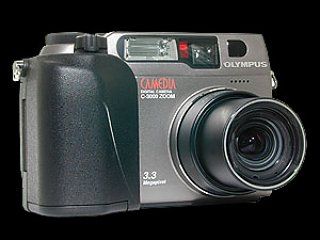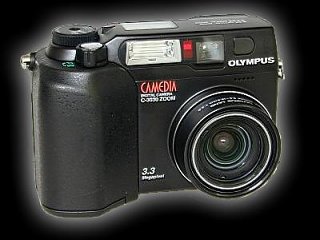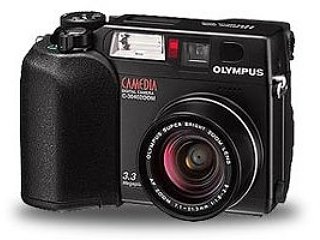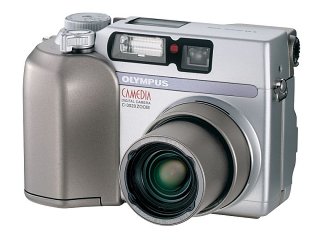
|
The Olympus 30x0 Digital Camera Line |

| My other pages related to the Olympus C-30x0 cameras |
|
This article discusses the similarities, and differences between cameras in the '30x0 series: the C-3000Z, C-3030Z, C-3020Z, and C-3040Z. It is provided as a companion to the series review. Background and introduction Only in '99 pictures from digital cameras begun to approach the quality of film-based ones. This was when, on one hand, their resolution reached two megapixels and, on the other, the progress in CCD sensors brought their tonal range closer to that of photographic film. This was the beginning of the end of the megapixel race. Two megapixels is enough for a decent 8x10-inch enlargement. Camera makers (at least the better ones) shifted focus to using these megapixels the right way. The trail was, I believe, blazed by two makers: Nikon, with their CoolPix 950, and Olympus, with the Camedia C-2000Z (later replaced with the improved C-2020Z). Both these were (and still are) good cameras, holding their own against the later competition. I was close to buying one or another, until in Spring, 2000 both were replaced with three-megapixel models: CoolPix 990, and the twin models of C-3030Z and C-3000Z, respectively. (In the Spring of 2001 both manufactures updated their, already successful, designs with the CoolPix 995 and C-3040Z). The choice between the Nikon and Olympus lines is, indeed, not so easy. Both are capable of taking excellent pictures which can quite easily be enlarged up to, and even above, 8x10 inches. Also, both allow for the camera user to take over and proceed in semi-manual or entirely manual mode. Since '2000, the choice of non-gadget cameras for an advanced amateur expanded, but not by much. In the three-megapixel range we've seen some notable offerings by Canon, Fuji, Sony and others. For many reasons, however, I consider the options from Olympus and Nikon worth most consideration. The Olympus models will be discussed here. Differences between C-3030Z and C-3000Z The main visible difference is in the body finish: black in the 3030, champagne-gray in the '3000. | ||

|
 | |
| C-3000Z | C-3030Z | |
|
The only difference in specs is that the '3030 has a 32MByte image buffer. This allows it to take the next picture sooner after the previous one. Otherwise both cameras are identical. What's new in the C-3040Z? The main new feature in the C-3040Z is the new lens. Its maximum aperture has increased from F/2.8 (at all focal lengths) in the C-3000/3030Z, to one varying from F/1.8 (short end) to F/2.6 (long end). The zoom range also has changed: from 32-96mm to 35-105mm, and this is rather not a good news, as I consider even 32mm not wide enough for my needs, especially in scenics and architecture photography. This is a significant trade-off and I'm not sure which lens I would prefer, especially that I couldn't see any difference in image quality. | ||
|
Then, a spot autofocus function has been added. Nice, but when did you use it last time? The same about the new multi-spot exposure metering capability (where the exposure is based on up to eight, individually selected by the user, spot measurements). Switching to both requires going through the LCD menus, which makes both improvements questionable.
Finally, there is also a separate adjustment for contrast (in addition to sharpness), and the cable-based USB connectivity has been improved. |
 C-3040Z | |
|
Regrettably, Olympus did not use this opportunity to address some common gripes about the C-3000/3030Z models: some frequently-used options accessible only from the LCD menus (notably: shutter and aperture priority modes, a very painful omission), illogical and confusing image storage options, insufficient coverage of the optical viewfinder, separate "macro mode". Some reviews note "improved user interface" in the 3040: improvements, if any, are few and of secondary importance. If you have a C-3000Z or C-3030Z, upgrading to the C-3040Z does not make sense. If you are looking for a new camera, look around: if you can buy one of the former models for significantly less then the latest one, go for it and use the savings for extra accessories. If you are shopping for a new camera, then the new C-3020 (see below) gives the C-3040Z a solid run for the money. C-3020Z - an upgrade or a downgrade? The C-3020Z seems to be a direct replacement for the very successful '3000, introducing some minor improvements, but also removing some features in the process. | ||
| The improvements include: spot autofocus (see above), the pre-packaged "scene modes" (handy if you are in a hurry), the user-defined "My Mode" setting (the name is, to put it mildly, moronic), one-touch white balance setting (where you can show the camera what you consider white, or neutrally gray), and, last but not least, two really useful features: long-exposure noise reduction (activated at shutter speeds longer than 1/2s), and USB storage class connectivity (handy with Win98SE or later). |
 C-3020Z | |
|
Olympus also claims faster shooting rate and reduced power consumption, and my observations seem to support this claim. The menu system was somewhat improved, but this is hardly a big difference. (Some Olympus sources also mention the multi-spot mode; this is not true, the feature is present only on the '3040.) As in the case of the '3040, I regret that Olympus didn't address any of the more serious gripes the users had about the (otherwise excellent) 3000/3030 siblings; see the previous section. Now, the omissions. Trying to bring the price of the C-3020Z down, Olympus removed some of the features of the previous model: TV video output, connectivity to external flash, and serial interface. Note that these are features related, in part at least, to mechanical design of the camera; the underlying electronics seems to be the same as in the C-3040Z. The good news is that all these changes, for better or worse, resulted in what may be the best value-for-money camera for a thinking amateur photographer. In the first days of December, 2001, I saw the '3020 at my local Best Buy store priced at $450, including a 64MB SmartMedia card and a copy of Adobe PhotoShop Elements! An extremely aggressive marketing move by Olympus, just in time for Christmas: even without these two extras I would consider the C-3020 the best buy in the three-megapixel category. The successors This article was first posted in June, 2000 as a part of the C-3000/3030Z review. As of the final (almost) update (June, 2003) the C-30x0Z series was replaced by a 4-megapixel line, the C-4000Z. The latter is an excellent mid-price camera, basically a C-3000Z (same body, same lens), with some improvements, of which the "super macro" seems to be foremost. I have used it, and liked is as much as I liked the '3000. In the end of 2002 Olympus significantly upgraded their "C" line with the five-megapixel C-5050Z. This model was a jump ahead, not only in terms of specifications, but also in build quality and handling. All this comes at a price: the '5050 was selling for almost twice as much as the '4000. Update of August, 2005: In 2003 the C-5060WZ was released, an essentially changed design. Although this was (and is) a very good camera, the departure from the original C-series philosophy was met with mixed reaction (see, for example, my comparison of both models). Initially selling well, it suffered a setback because Olympus botched their PR by not-too-smart handling of the widespread mode dial problem. In 2004 there was a successor to that model — the seven-megapixel C-7070WZ. This is essentially the same camera as the '5060, just with two megapixels more. Altogether, I consider the '7070 to be the best offering on the advanced compact market as of this writing. Still kicking From the five-year perspective, the 30x0-series withstood the test of time well, still capable of delivering results comparable with those from newer models. If you have one, do not rush retiring it. If you are shopping on a budget and come across a used C-30x0 at a good price, give it a close look. You may get yourself a friend. An older, but still very capable friend. | ||

| My other pages related to the Olympus C-30x0 cameras |
|
Camedia® and Olympus® are registered trademarks of Olympus Corporation.
This page is not sponsored or endorsed by Olympus (or anyone else) and presents solely the views of the author. |
| Home: wrotniak.net | Search this site | Change font size |
|
Posted 2000/06/25; last updated 2005/08/07 Split into three parts 2005/08/07 | Copyright © 2000-2006 by J. Andrzej Wrotniak |